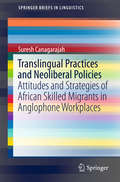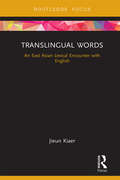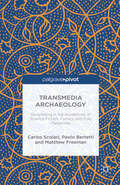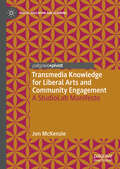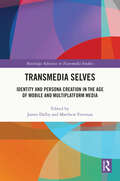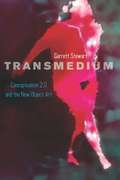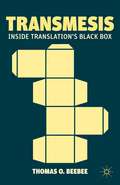- Table View
- List View
Translingual Practices and Neoliberal Policies: Attitudes and Strategies of African Skilled Migrants in Anglophone Workplaces (SpringerBriefs in Linguistics)
by Suresh CanagarajahThis book responds to recent criticisms that the research and theorization of multilingualism on the part of applied linguists are in collusion with neoliberal policies and economic interests. While acknowledging that neoliberal agencies can appropriate diverse languages and language practices, including resources and dispositions theorized by scholars of multilingualism, it argues that a distinction must be made between the different language ideologies informing communicative practices. Those of neoliberal agencies are motivated by distinct ideological orientations that diverge from the theorization of multilingual practices by critical applied linguists. In addressing this issue, the book draws on the author’s empirical research on skilled migration to demonstrate how sub-Saharan African professionals in English-dominant workplaces in the UK, USA, Australia, and South Africa resist the neoliberal communicative expectations and employ alternate practices informed by critical dispositions. These practices have the potential to transform neoliberal orientations on material development. The book labels the latter as informed by a postcolonial language ideology, to distinguish them from those of neoliberalism. While neoliberal agencies approach languages as being instrumental for profit-making purposes, the author’s informants focus on the synergy between languages to generate new meanings and norms, which are strategically negotiated in pursuit of ethical interests, inclusive interactions, and holistic ecological development. As such, the book clearly illustrates that the way critical scholars and multilinguals relate to language diversity is different from the way neoliberal policies and agencies use multilingualism for their own purposes.
Translingual Words: An East Asian Lexical Encounter with English
by Jieun KiaerTranslingual Words is a detailed case study on lexical integration, or mediation, occurring between East Asian languages and English(es). In Part I, specific examples from global linguistic corpora are used to discuss the issues involved in lexical interaction between East Asia and the English-speaking world. Part II explores the spread of East Asian words in English, while Part III discusses English words which can be found in East Asian languages. Translingual Words presents a novel approach on hybrid words by challenging the orthodox ideas on lexical borrowing and explaining the dynamic growth of new words based on translingualism and transculturalism.
Translingual Words: An East Asian Lexical Encounter with English
by Jieun KiaerTranslingual Words is a detailed case study on lexical integration, or mediation, occurring between East Asian languages and English(es). In Part I, specific examples from global linguistic corpora are used to discuss the issues involved in lexical interaction between East Asia and the English-speaking world. Part II explores the spread of East Asian words in English, while Part III discusses English words which can be found in East Asian languages. Translingual Words presents a novel approach on hybrid words by challenging the orthodox ideas on lexical borrowing and explaining the dynamic growth of new words based on translingualism and transculturalism.
Translinguistics: Negotiating Innovation and Ordinariness
by Jerry Lee Sender DovchinTranslinguistics represents a powerful alternative to conventional paradigms of language such as bilingualism and code-switching, which assume the compartmentalization of different 'languages' into fixed and arbitrary boundaries. Translinguistics more accurately reflects the fluid use of linguistic and semiotic resources in diverse communities. This ground-breaking volume showcases work from leading as well as emerging scholars in sociolinguistics and other language-oriented disciplines and collectively explores and aims to reconcile the distinction between 'innovation' and 'ordinariness' in translinguistics. Features of this book include: 18 chapters from 28 scholars, representing a range of academic disciplines and institutions from 11 countries around the world; research on understudied communities and geographic contexts, including those of Latin America, South Asia, and Central Asia; several chapters devoted to the diversity of communication in digital contexts. Edited by two of the most innovative scholars in the field, Translinguistics: Negotiating Innovation and Ordinariness is essential reading for scholars and students interested in the question of multilingualism across a variety of subject areas.
Translinguistics: Negotiating Innovation and Ordinariness
by Jerry Won Lee Sender DovchinTranslinguistics represents a powerful alternative to conventional paradigms of language such as bilingualism and code-switching, which assume the compartmentalization of different 'languages' into fixed and arbitrary boundaries. Translinguistics more accurately reflects the fluid use of linguistic and semiotic resources in diverse communities. This ground-breaking volume showcases work from leading as well as emerging scholars in sociolinguistics and other language-oriented disciplines and collectively explores and aims to reconcile the distinction between 'innovation' and 'ordinariness' in translinguistics. Features of this book include: 18 chapters from 28 scholars, representing a range of academic disciplines and institutions from 11 countries around the world; research on understudied communities and geographic contexts, including those of Latin America, South Asia, and Central Asia; several chapters devoted to the diversity of communication in digital contexts. Edited by two of the most innovative scholars in the field, Translinguistics: Negotiating Innovation and Ordinariness is essential reading for scholars and students interested in the question of multilingualism across a variety of subject areas.
Translocality in Contemporary City Novels (Literary Urban Studies)
by Lena MattheisTranslocality in Contemporary City Novels responds to the fact that twenty-first-century Anglophone novels are increasingly characterised by translocality—the layering and blending of two or more distant settings. Considering translocal and transcultural writing as a global phenomenon, this book draws on multidisciplinary research, from globalisation theory to the study of narratives to urban studies, to explore a corpus of thirty-two novels—by authors such as Chimamanda Ngozi Adichie, Dionne Brand, Kiran Desai, and Xiaolu Guo—set in a total of ninety-seven cities. Lena Mattheis examines six of the most common strategies used in contemporary urban fiction to make translocal experiences of the world narratable and turn them into relatable stories: simultaneity, palimpsests, mapping, scaling, non-places, and haunting. Combining and developing further theories, approaches, and techniques from a variety of research fields—including narratology, human geography, transculturality, diaspora spaces, and postcolonial perspectives—Mattheis develops a set of cross-disciplinary techniques in literary urban studies.
Transmedia Archaeology: Storytelling in the Borderlines of Science Fiction, Comics and Pulp Magazines
by C. Scolari P. Bertetti M. FreemanIn this book, the authors examine manifestations of transmedia storytelling in different historical periods and countries, spanning the UK, the US and Argentina. It takes us into the worlds of Conan the Barbarian, Superman and El Eternauta, introduces us to the archaeology of transmedia, and reinstates the fact that it's not a new phenomenon.
Transmedia Knowledge for Liberal Arts and Community Engagement: A StudioLab Manifesto (Digital Education and Learning)
by Jon McKenzieThis book sets forth a pedagogy for renewing the liberal arts by combining critical thinking, media activism, and design thinking. Using the StudioLab approach, the author seeks to democratize the social and technical practices of digital culture just as nineteenth century education sought to democratize literacy. This production of transmedia knowledge—from texts and videos to comics and installations—moves students between seminar, studio, lab, and field activities. The book also wrestles with the figure of Plato and the very medium of knowledge to re-envision higher education in contemporary societies, issuing a call for community engagement as a form of collective thought-action.
Transmedia Selves: Identity and Persona Creation in the Age of Mobile and Multiplatform Media (Routledge Advances in Transmedia Studies)
by James Dalby Matthew FreemanThis book examines the mediated shift in the contemporary human condition, focusing on the ways in which we synthesise with media content in daily life, essentially transmediating ourselves into new forms and (re)creating ourselves across media. Across an international roster of essays, this book establishes a transdisciplinary theory for the ‘transmedia self’, exploring how technological ubiquity and digital self-determination combine with themes and disciplines such as celebrity culture, fandom, play, politics, and ultimately broader self-conception and projection to inform the creation of transmedia identities in the twenty-first century. Specifically, the book repositions transmediality as key to understanding the formation of identity in a post-digital media culture and transmedia age, where our lives are interlaced, intermingled, and narrativised across a range of media platforms and interfaces. This book is ideal for scholars and students interested in transmedia storytelling, cultural studies, media studies, sociology, philosophy, and politics.
Transmedia Selves: Identity and Persona Creation in the Age of Mobile and Multiplatform Media (Routledge Advances in Transmedia Studies)
This book examines the mediated shift in the contemporary human condition, focusing on the ways in which we synthesise with media content in daily life, essentially transmediating ourselves into new forms and (re)creating ourselves across media. Across an international roster of essays, this book establishes a transdisciplinary theory for the ‘transmedia self’, exploring how technological ubiquity and digital self-determination combine with themes and disciplines such as celebrity culture, fandom, play, politics, and ultimately broader self-conception and projection to inform the creation of transmedia identities in the twenty-first century. Specifically, the book repositions transmediality as key to understanding the formation of identity in a post-digital media culture and transmedia age, where our lives are interlaced, intermingled, and narrativised across a range of media platforms and interfaces. This book is ideal for scholars and students interested in transmedia storytelling, cultural studies, media studies, sociology, philosophy, and politics.
Transmedial Narration: Narratives and Stories in Different Media
by Lars ElleströmThis open access book is a methodical treatise on narration in different types of media. A theoretical rather than a historical study, Transmedial Narration is relevant for an understanding of narration in all times, including our own. By reconstructing the theoretical framework of transmedial narration, this book enables the inclusion of all kinds of communicative media forms on their own terms.The treatise is divided into three parts. Part I presents established and newly developed concepts that are vital for formulating a nuanced theoretical model of transmedial narration. Part II investigates the specific transmedial media characteristics that are most central for realizing narratives in a plenitude of different media types. Finally, Part III contains brief studies in which the narrative potentials of painting, instrumental music, mathematical equations, and guided tours are illuminated with the aid of the theoretical framework developed throughout the book. Suitable for advanced students and scholars, this book provides tools to disentangle the narrative potential of any form of communication.
Transmedial Perspectives on Humour and Translation: From Page to Screen to Stage (Routledge Advances in Translation and Interpreting Studies)
by Loukia Kostopoulou and Vasiliki MisiouThis innovative collection spotlights the role of media crossovers in humour translation and how the latter is conveyed through new means of communication. The volume offers an in-depth exploration of the entanglements of film, theatre, literature, TV, the Internet, etc., within the framework of transmediality and their influence on the practice of translating humour. Chapters focus on the complex web of interrelationships shaped by and shaping the process(es) of transformation and adaptation that take place across media and across languages and cultures. Situating translation practices and innovations within an interdisciplinary context, the volume underscores the hybrid nature and complex semiotics of humour and the plurality of possibilities for new insights that contemporary approaches offer driven by technological advancements in the industry. The book will be of particular interest to scholars and researchers in the fields of Translation Studies, Humour Studies, Audiovisual Translation, Media Studies, and Adaptation Studies.
Transmedial Perspectives on Humour and Translation: From Page to Screen to Stage (Routledge Advances in Translation and Interpreting Studies)
This innovative collection spotlights the role of media crossovers in humour translation and how the latter is conveyed through new means of communication. The volume offers an in-depth exploration of the entanglements of film, theatre, literature, TV, the Internet, etc., within the framework of transmediality and their influence on the practice of translating humour. Chapters focus on the complex web of interrelationships shaped by and shaping the process(es) of transformation and adaptation that take place across media and across languages and cultures. Situating translation practices and innovations within an interdisciplinary context, the volume underscores the hybrid nature and complex semiotics of humour and the plurality of possibilities for new insights that contemporary approaches offer driven by technological advancements in the industry. The book will be of particular interest to scholars and researchers in the fields of Translation Studies, Humour Studies, Audiovisual Translation, Media Studies, and Adaptation Studies.
Transmediations: Communication Across Media Borders (Routledge Studies in Multimodality)
by Niklas Salmose Lars ElleströmThis collection offers a multi-faceted exploration of transmediations, the processes of transfer and transformation that occur when communicative acts in one medium are mediated again through another. While previous research has explored these processes from a broader perspective, Salmose and Elleström argue that a better understanding is needed of the extent to which the outcomes of communicative acts are modified when transferred across multimodal media in order to foster a better understanding of communication more generally. Using this imperative as a point of departure, the book details a variety of transmediations, viewed through four different lenses. The first part of the volume looks at narrative transmediations, building on existing work done by Marie-Laure Ryan on transmedia storytelling. The second section focuses on the spatial dynamics involved in media transformation as well as the role of the human body as a perceptive agent and a medium in its own right. The third part investigates new, radical boundaries and media types in transmediality and hence shows its versatility as a method of analyzing complex and contemporary communicative discourses. The fourth and final part explores the challenges involved in transmediating scientific data into the narrative format in the context of environmental issues. Taken together, these sections highlight a range of case studies of transmediations and, in turn, the complexity and variety of the process, informed by the methodologies of the different disciplines to which they belong. This innovative volume will be of particular interest to students and scholars in multimodality, communication, intermediality, semiotics, and adaptation studies.
Transmediations: Communication Across Media Borders (Routledge Studies in Multimodality)
by Niklas Salmose Lars ElleströmThis collection offers a multi-faceted exploration of transmediations, the processes of transfer and transformation that occur when communicative acts in one medium are mediated again through another. While previous research has explored these processes from a broader perspective, Salmose and Elleström argue that a better understanding is needed of the extent to which the outcomes of communicative acts are modified when transferred across multimodal media in order to foster a better understanding of communication more generally. Using this imperative as a point of departure, the book details a variety of transmediations, viewed through four different lenses. The first part of the volume looks at narrative transmediations, building on existing work done by Marie-Laure Ryan on transmedia storytelling. The second section focuses on the spatial dynamics involved in media transformation as well as the role of the human body as a perceptive agent and a medium in its own right. The third part investigates new, radical boundaries and media types in transmediality and hence shows its versatility as a method of analyzing complex and contemporary communicative discourses. The fourth and final part explores the challenges involved in transmediating scientific data into the narrative format in the context of environmental issues. Taken together, these sections highlight a range of case studies of transmediations and, in turn, the complexity and variety of the process, informed by the methodologies of the different disciplines to which they belong. This innovative volume will be of particular interest to students and scholars in multimodality, communication, intermediality, semiotics, and adaptation studies.
Transmedium: Conceptualism 2.0 and the New Object Art
by Garrett StewartIf you attend a contemporary art exhibition today, you’re unlikely to see much traditional painting or sculpture. Indeed, artists today are preoccupied with what happens when you leave behind assumptions about particular media—such as painting, or woodcuts—and instead focus on collisions between them, and the new forms and ideas that those collisions generate. Garrett Stewart in Transmedium dubs this new approach Conceptualism 2.0, an allusion in part to the computer images that are so often addressed by these works. A successor to 1960s Conceptualism, which posited that a material medium was unnecessary to the making of art, Conceptualism 2.0 features artworks that are transmedial, that place the aesthetic experience itself deliberately at the boundary between often incommensurable media. The result, Stewart shows, is art whose forced convergences break open new possibilities that are wholly surprising, intellectually enlightening, and often uncanny.
Transmedium: Conceptualism 2.0 and the New Object Art
by Garrett StewartIf you attend a contemporary art exhibition today, you’re unlikely to see much traditional painting or sculpture. Indeed, artists today are preoccupied with what happens when you leave behind assumptions about particular media—such as painting, or woodcuts—and instead focus on collisions between them, and the new forms and ideas that those collisions generate. Garrett Stewart in Transmedium dubs this new approach Conceptualism 2.0, an allusion in part to the computer images that are so often addressed by these works. A successor to 1960s Conceptualism, which posited that a material medium was unnecessary to the making of art, Conceptualism 2.0 features artworks that are transmedial, that place the aesthetic experience itself deliberately at the boundary between often incommensurable media. The result, Stewart shows, is art whose forced convergences break open new possibilities that are wholly surprising, intellectually enlightening, and often uncanny.
Transmedium: Conceptualism 2.0 and the New Object Art
by Garrett StewartIf you attend a contemporary art exhibition today, you’re unlikely to see much traditional painting or sculpture. Indeed, artists today are preoccupied with what happens when you leave behind assumptions about particular media—such as painting, or woodcuts—and instead focus on collisions between them, and the new forms and ideas that those collisions generate. Garrett Stewart in Transmedium dubs this new approach Conceptualism 2.0, an allusion in part to the computer images that are so often addressed by these works. A successor to 1960s Conceptualism, which posited that a material medium was unnecessary to the making of art, Conceptualism 2.0 features artworks that are transmedial, that place the aesthetic experience itself deliberately at the boundary between often incommensurable media. The result, Stewart shows, is art whose forced convergences break open new possibilities that are wholly surprising, intellectually enlightening, and often uncanny.
Transmedium: Conceptualism 2.0 and the New Object Art
by Garrett StewartIf you attend a contemporary art exhibition today, you’re unlikely to see much traditional painting or sculpture. Indeed, artists today are preoccupied with what happens when you leave behind assumptions about particular media—such as painting, or woodcuts—and instead focus on collisions between them, and the new forms and ideas that those collisions generate. Garrett Stewart in Transmedium dubs this new approach Conceptualism 2.0, an allusion in part to the computer images that are so often addressed by these works. A successor to 1960s Conceptualism, which posited that a material medium was unnecessary to the making of art, Conceptualism 2.0 features artworks that are transmedial, that place the aesthetic experience itself deliberately at the boundary between often incommensurable media. The result, Stewart shows, is art whose forced convergences break open new possibilities that are wholly surprising, intellectually enlightening, and often uncanny.
Transmedium: Conceptualism 2.0 and the New Object Art
by Garrett StewartIf you attend a contemporary art exhibition today, you’re unlikely to see much traditional painting or sculpture. Indeed, artists today are preoccupied with what happens when you leave behind assumptions about particular media—such as painting, or woodcuts—and instead focus on collisions between them, and the new forms and ideas that those collisions generate. Garrett Stewart in Transmedium dubs this new approach Conceptualism 2.0, an allusion in part to the computer images that are so often addressed by these works. A successor to 1960s Conceptualism, which posited that a material medium was unnecessary to the making of art, Conceptualism 2.0 features artworks that are transmedial, that place the aesthetic experience itself deliberately at the boundary between often incommensurable media. The result, Stewart shows, is art whose forced convergences break open new possibilities that are wholly surprising, intellectually enlightening, and often uncanny.
Transmedium: Conceptualism 2.0 and the New Object Art
by Garrett StewartIf you attend a contemporary art exhibition today, you’re unlikely to see much traditional painting or sculpture. Indeed, artists today are preoccupied with what happens when you leave behind assumptions about particular media—such as painting, or woodcuts—and instead focus on collisions between them, and the new forms and ideas that those collisions generate. Garrett Stewart in Transmedium dubs this new approach Conceptualism 2.0, an allusion in part to the computer images that are so often addressed by these works. A successor to 1960s Conceptualism, which posited that a material medium was unnecessary to the making of art, Conceptualism 2.0 features artworks that are transmedial, that place the aesthetic experience itself deliberately at the boundary between often incommensurable media. The result, Stewart shows, is art whose forced convergences break open new possibilities that are wholly surprising, intellectually enlightening, and often uncanny.
Transmesis: Inside Translation’s Black Box
by Thomas O. BeebeeThis study compares modern and contemporary literary works from around the globe that have translation as a central theme, and that treat one of four of said black-box issues: language as embodiment; unknown language; conversion; and postcolonial derivations.
The Transmission of "Beowulf": Language, Culture, and Scribal Behavior (Myth and Poetics II)
by Leonard NeidorfBeowulf, like The Iliad and The Odyssey, is a foundational work of Western literature that originated in mysterious circumstances. In The Transmission of Beowulf, Leonard Neidorf addresses philological questions that are fundamental to the study of the poem. Is Beowulf the product of unitary or composite authorship? How substantially did scribes alter the text during its transmission, and how much time elapsed between composition and preservation? Neidorf answers these questions by distinguishing linguistic and metrical regularities, which originate with the Beowulf poet, from patterns of textual corruption, which descend from copyists involved in the poem’s transmission. He argues, on the basis of archaic features that pervade Beowulf and set it apart from other Old English poems, that the text preserved in the sole extant manuscript (ca. 1000) is essentially the work of one poet who composed it circa 700. Of course, during the poem’s written transmission, several hundred scribal errors crept into its text. These errors are interpreted in the central chapters of the book as valuable evidence for language history, cultural change, and scribal practice. Neidorf’s analysis reveals that the scribes earnestly attempted to standardize and modernize the text’s orthography, but their unfamiliarity with obsolete words and ancient heroes resulted in frequent errors. The Beowulf manuscript thus emerges from his study as an indispensible witness to processes of linguistic and cultural change that took place in England between the eighth and eleventh centuries. An appendix addresses J. R. R. Tolkien’s Beowulf: A Translation and Commentary, which was published in 2014. Neidorf assesses Tolkien’s general views on the transmission of Beowulf and evaluates his position on various textual issues.
Transmitting Minority Languages: Complementary Reversing Language Shift Strategies (Palgrave Studies in Minority Languages and Communities)
by Michael Hornsby Wilson McLeodThis book gives fresh insight into the diverse ways in which the transmission of minority and heritage languages is carried out in a range of sociolinguistic contexts. When traditional modes of intergenerational transmission begin to break down, minority language and diaspora communities resort to other modes of transmission, out of necessity, to complement traditional mechanisms and secure language maintenance. This volume brings together a broad range of studies of these alternative modes of transmission, examining the complex and diverse practical, ideological and personal challenges that arise in different settings. Beyond addressing the dynamics of language use within the home and family, the book also emphasises the importance of the participation of the minority community itself in language and cultural transmission. These mechanisms and initiatives, sometimes overlooked or dismissed in the academic literature, will prove to be essential in maintaining and ensuring the survival of minority and heritage languages into the 21st century and beyond. The twelve chapters in the book are divided into four sections (intergenerational transmission; transmission in post-traditional families; alternatives to ‘traditional’ transmission; and transmission in diasporic contexts), and the language contexts, both minoritised and diasporic, which are discussed include Basque, Breton, Galician, Guernesais, Irish, Māori, Russian, Scottish Gaelic, Sorbian and Spanish. This book will be of interest to students and scholars of sociolinguistics, language acquisition, heritage language maintenance and revitalization, and language policy and planning.
Transmodern Perspectives on Contemporary Literatures in English (Routledge Studies in Contemporary Literature)
by Jessica Aliaga-Lavrijsen José María Yebra-PertusaTransmodern Perspectives on Contemporary Literatures in English offers a constructive dialogue on the concept of the transmodern, focusing on the works by very different contemporary authors from all over the world, such as: Chimanda Ngozi Adichie, Margaret Atwood, Sebastian Barry, A. S. Byatt, Tabish Khair, David Mitchell, Alice Munroe, Harry Parker, Caryl Phillips, Richard Rodriguez, Alan Spence, Tim Winton and Kenneth White. The volume offers a thorough questioning of the concept of the transmodern, as well as an informed insight into the future formal and thematic development of literatures in English.
